
The Iberians were an ancient people settled in the eastern and southern coasts of the Iberian peninsula, at least from the 6th century BC. They are described in Greek and Roman sources. Roman sources also use the term Hispani to refer to the Iberians.
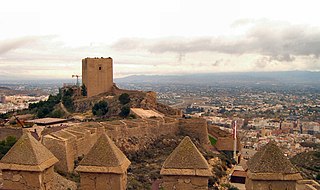
Lorca is a municipality and city in the autonomous community of the Region of Murcia in south-eastern Spain, 58 kilometres (36 mi) southwest of the city of Murcia. The municipality had a population of 95,515 in 2020, up from the 2001 census total of 77,477. Lorca is the municipality with the second largest surface area in Spain, 1,675.21 km2 (646.80 sq mi), after Cáceres. The city is home to Lorca Castle and the Collegiate church dedicated to St. Patrick.
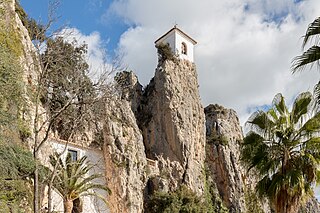
El Castell de Guadalest or simply Guadalest, is a Valencian town and municipality located in a mountainous area of the comarca of Marina Baixa, in the province of Alicante, Spain. Guadalest has an area of 16 km² and, according to the 2002 census, a total population of 189 inhabitants.

The Via Augusta was the longest and busiest of the major roads built by the Romans in ancient Hispania. According to historian Pierre Sillières, who has supervised excavation of Roman sites in Spain to identify the exact route followed by the Via Augusta, it was more a system of roads than a single road. Approximately 1,500 km (930 mi) long, the Via Augusta was built to link Spain with Italy, running from the southwestern coastal city of Gades (Cádiz) to the Pyrenees Mountains along inland valleys parallel to the coast of the Mediterranean Sea. As the main axis of the road network in Roman Hispania, it appears in ancient sources such as the itinerary inscribed on the Vicarello Cups as well in as the Antonine Itinerary.

Xativa Castle is a castle located in the city of Xàtiva near Valencia, Spain. It consists of a twin fortification divided between the older "Castillo Menor", built on the Iberian and Roman remains of the site, and the more recent "Castillo Mayor", built during the medieval period. It sits at a height of 310 meters above the modern-day city.

The National Archaeological Museum is a museum in Madrid, Spain. It is located on Calle de Serrano beside the Plaza de Colón, sharing its building with the National Library of Spain.
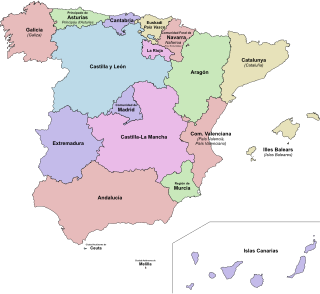
Jérica is a town in the Castellón province of Valencian Community, Spain. It is in the comarca (region) of Alto Palancia. Its population was 1,703 at the end of 2009.

Sagunto is a municipality of Spain, located in the province of Valencia, Valencian Community. It belongs to the modern fertile comarca of Camp de Morvedre. It is located approximately 30 km (19 mi) north of the city of Valencia, close to the Costa del Azahar on the Mediterranean Sea.
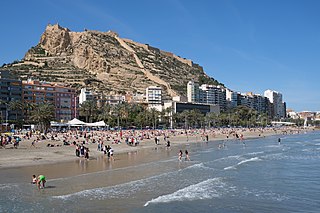
Santa Bárbara Castle is a fortification in the center of Alicante, Spain. It stands on Mount Benacantil bordering the sea, which gave it enormous strategic value since from it you can see the entire bay of Alicante and its land surroundings. The image of the mountain from the beach resembles a face, which is why it is called "the face of the Moor" and is an icon of the city of Alicante.

The history of Alicante spans thousands of years. Alicante has been regarded as a strategic military location on the Mediterranean coast of Spain since ancient times. It is protected on the southwest by Cape Santa Pola and on the southeast by Cape Huerta. The fortified complex of Santa Bárbara Castle, the older parts of which were built in the 9th century, dominates the city from a height of 160 m atop Mount Benacantil, a rocky massif overlooking the sea.

Alhama de Murcia is a Spanish municipality in the autonomous community of the Region of Murcia. It is located in the north of the southern half of the region. The municipality shares borders with Librilla in its north, Murcia in its northeast, Fuente Álamo de Murcia in its east, Mazarrón in its south, Totana in its west and Mula in its northwest.

La Vall d'Uixó is a town situated in eastern Spain, in the Valencian province of Castelló. La Vall is located 25 km to the south of the province's capital Castelló, 45 km to the north of the community's capital Valencia and 8 km to the Mediterranean Sea, so it is at 118 m above sea level.

The Villar del Arzobispo Formation is a Late Jurassic to possibly Early Cretaceous geologic formation in eastern Spain. It is equivalent in age to the Lourinhã Formation of Portugal. It was originally thought to date from the Late Tithonian-Middle Berriasian, but more recent work suggests a Kimmeridigan-Late Tithonian, possibly dating to the Early Berriasian in some areas. The Villar del Arzobispo Formation's age in the area of Riodeva in Spain has been dated based on stratigraphic correlations as middle-upper Tithonian, approximately 145-141 million years old. In the area of Galve, the formation potentially dates into the earliest Cretaceous.
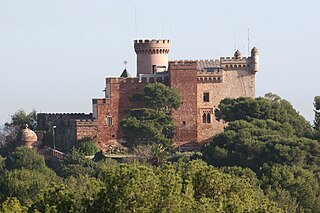
Castelldefels Castle is a frontier fortress in the town of Castelldefels, near Barcelona in Spain, that was built to defend the frontier of the Carolingian Empire against neighbouring Muslim territories, particularly the Caliphate of Córdoba. The fortress was first recorded in the 10th century, as was the former parish church of St. Mary, contained within its outer wall.

The Castle of Burgos was a castle and alcázar, located in the city of Burgos, in the hill of San Miguel to 75 metres (246 ft) above the city and to 981 metres (3,219 ft) above the sea. This hill was the subject of archaeological surveys by General Centeno in the years 1925 and 1926 trying to find Napoleonic military files from when the French in their retreat blew up the fortress. According to the results obtained in this excavation the origin of the castle dates to the Visigoths, and its oldest parts, to the Romans.

The history of Valencia, one of the oldest cities in Spain, begins over 2100 years ago with its founding as a Roman colony under the name "Valentia Edetanorum" on the site of a former Iberian town, by the river Turia in the province of Edetania. The Roman consul Decimus Junius Brutus Callaicus transferred about 2,000 veteran soldiers who had fought under him to Valentia in 138 BC. Valentia lay in a strategic location near the sea on a river island that would later be crossed by the Via Augusta. Pompey razed Valentia to the ground in 75 BC; it was rebuilt about fifty years later with large infrastructure projects, and by the mid-1st century, was experiencing rapid urban growth with many colonists from Italy.
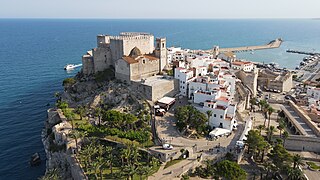
Peniscola Castle is a castle in Peniscola, Castellón, Valencian Community, Spain. The castle is restored and is open to the public.
Roser Maestro Moliner is a Spanish communist politician and member of the Congress of Deputies since the 13th legislature. She is a member of the United Left of the Valencian Country and the Communist Party of the Valencian Country.
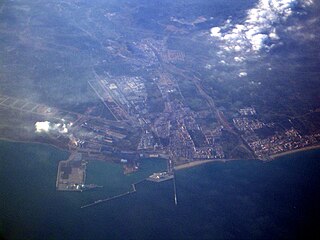
Puerto de Sagunto is a Spanish locality pertaining to Sagunto, which is located at the mouth of the Palancia river and in the north of the province of Valencia. It is the largest urban nucleus in Camp de Morvedre, with 44,428 inhabitants (2019).
























